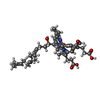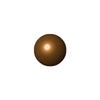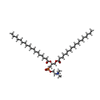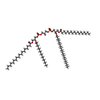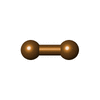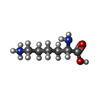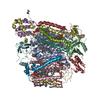+ Open data
Open data
- Basic information
Basic information
| Entry | Database: EMDB / ID: EMD-22447 | |||||||||
|---|---|---|---|---|---|---|---|---|---|---|
| Title | Plant Mitochondrial complex IV from Vigna radiata | |||||||||
 Map data Map data | Plant Mitochondrial complex IV from Vigna radiata | |||||||||
 Sample Sample |
| |||||||||
| Function / homology |  Function and homology information Function and homology informationrespiratory chain complex IV / mitochondrial respiratory chain complex IV / mitochondrial respirasome / mitochondrial electron transport, cytochrome c to oxygen /  cytochrome-c oxidase activity / cytochrome-c oxidase activity /  respirasome / respirasome /  mitochondrial inner membrane / membrane => GO:0016020 / copper ion binding / mitochondrial inner membrane / membrane => GO:0016020 / copper ion binding /  mitochondrion mitochondrionSimilarity search - Function | |||||||||
| Biological species |   Vigna radiata (mung bean) / Vigna radiata (mung bean) /   Mung bean (mung bean) Mung bean (mung bean) | |||||||||
| Method |  single particle reconstruction / single particle reconstruction /  cryo EM / Resolution: 3.8 Å cryo EM / Resolution: 3.8 Å | |||||||||
 Authors Authors | Maldonado M / Letts JA | |||||||||
 Citation Citation |  Journal: Elife / Year: 2021 Journal: Elife / Year: 2021Title: Atomic structures of respiratory complex III, complex IV, and supercomplex III-IV from vascular plants. Authors: Maria Maldonado / Fei Guo / James A Letts /  Abstract: Mitochondrial complex III (CIII) and complex IV (CIV), which can associate into a higher-order supercomplex (SC III+IV), play key roles in respiration. However, structures of these plant complexes ...Mitochondrial complex III (CIII) and complex IV (CIV), which can associate into a higher-order supercomplex (SC III+IV), play key roles in respiration. However, structures of these plant complexes remain unknown. We present atomic models of CIII, CIV, and SC III+IV from determined by single-particle cryoEM. The structures reveal plant-specific differences in the MPP domain of CIII and define the subunit composition of CIV. Conformational heterogeneity analysis of CIII revealed long-range, coordinated movements across the complex, as well as the motion of CIII's iron-sulfur head domain. The CIV structure suggests that, in plants, proton translocation does not occur via the H channel. The supercomplex interface differs significantly from that in yeast and bacteria in its interacting subunits, angle of approach and limited interactions in the mitochondrial matrix. These structures challenge long-standing assumptions about the plant complexes and generate new mechanistic hypotheses. | |||||||||
| History |
|
- Structure visualization
Structure visualization
| Movie |
 Movie viewer Movie viewer |
|---|---|
| Structure viewer | EM map:  SurfView SurfView Molmil Molmil Jmol/JSmol Jmol/JSmol |
| Supplemental images |
- Downloads & links
Downloads & links
-EMDB archive
| Map data |  emd_22447.map.gz emd_22447.map.gz | 480.1 MB |  EMDB map data format EMDB map data format | |
|---|---|---|---|---|
| Header (meta data) |  emd-22447-v30.xml emd-22447-v30.xml emd-22447.xml emd-22447.xml | 29.3 KB 29.3 KB | Display Display |  EMDB header EMDB header |
| FSC (resolution estimation) |  emd_22447_fsc.xml emd_22447_fsc.xml | 18.2 KB | Display |  FSC data file FSC data file |
| Images |  emd_22447.png emd_22447.png | 84.6 KB | ||
| Masks |  emd_22447_msk_1.map emd_22447_msk_1.map | 512 MB |  Mask map Mask map | |
| Others |  emd_22447_half_map_1.map.gz emd_22447_half_map_1.map.gz emd_22447_half_map_2.map.gz emd_22447_half_map_2.map.gz | 411.5 MB 411.5 MB | ||
| Archive directory |  http://ftp.pdbj.org/pub/emdb/structures/EMD-22447 http://ftp.pdbj.org/pub/emdb/structures/EMD-22447 ftp://ftp.pdbj.org/pub/emdb/structures/EMD-22447 ftp://ftp.pdbj.org/pub/emdb/structures/EMD-22447 | HTTPS FTP |
-Related structure data
| Related structure data |  7jroMC  7jrgC  7jrpC C: citing same article ( M: atomic model generated by this map |
|---|---|
| Similar structure data | |
| EM raw data |  EMPIAR-10586 (Title: Cryo electron micrographs of digitonin-solubilized, amphipol-stabilized, sucrose-gradient-purified V. radiata mitochondrial membranes - mixed fraction containing CI*, CIII2 and SC III2+IV EMPIAR-10586 (Title: Cryo electron micrographs of digitonin-solubilized, amphipol-stabilized, sucrose-gradient-purified V. radiata mitochondrial membranes - mixed fraction containing CI*, CIII2 and SC III2+IVData size: 6.7 TB Data #1: Raw movies of mixed sample used for determination of mung bean respiratory CI*, CIII2, CIV and SC III2+IV [micrographs - multiframe]) |
- Links
Links
| EMDB pages |  EMDB (EBI/PDBe) / EMDB (EBI/PDBe) /  EMDataResource EMDataResource |
|---|---|
| Related items in Molecule of the Month |
- Map
Map
| File |  Download / File: emd_22447.map.gz / Format: CCP4 / Size: 512 MB / Type: IMAGE STORED AS FLOATING POINT NUMBER (4 BYTES) Download / File: emd_22447.map.gz / Format: CCP4 / Size: 512 MB / Type: IMAGE STORED AS FLOATING POINT NUMBER (4 BYTES) | ||||||||||||||||||||||||||||||||||||||||||||||||||||||||||||||||||||
|---|---|---|---|---|---|---|---|---|---|---|---|---|---|---|---|---|---|---|---|---|---|---|---|---|---|---|---|---|---|---|---|---|---|---|---|---|---|---|---|---|---|---|---|---|---|---|---|---|---|---|---|---|---|---|---|---|---|---|---|---|---|---|---|---|---|---|---|---|---|
| Annotation | Plant Mitochondrial complex IV from Vigna radiata | ||||||||||||||||||||||||||||||||||||||||||||||||||||||||||||||||||||
| Voxel size | X=Y=Z: 0.8332 Å | ||||||||||||||||||||||||||||||||||||||||||||||||||||||||||||||||||||
| Density |
| ||||||||||||||||||||||||||||||||||||||||||||||||||||||||||||||||||||
| Symmetry | Space group: 1 | ||||||||||||||||||||||||||||||||||||||||||||||||||||||||||||||||||||
| Details | EMDB XML:
CCP4 map header:
| ||||||||||||||||||||||||||||||||||||||||||||||||||||||||||||||||||||
-Supplemental data
-Mask #1
| File |  emd_22447_msk_1.map emd_22447_msk_1.map | ||||||||||||
|---|---|---|---|---|---|---|---|---|---|---|---|---|---|
| Projections & Slices |
| ||||||||||||
| Density Histograms |
-Half map: Plant Mitochondrial complex IV from Vigna radiata. Half map 1.
| File | emd_22447_half_map_1.map | ||||||||||||
|---|---|---|---|---|---|---|---|---|---|---|---|---|---|
| Annotation | Plant Mitochondrial complex IV from Vigna radiata. Half map 1. | ||||||||||||
| Projections & Slices |
| ||||||||||||
| Density Histograms |
-Half map: Plant Mitochondrial complex IV from Vigna radiata. Half map 2.
| File | emd_22447_half_map_2.map | ||||||||||||
|---|---|---|---|---|---|---|---|---|---|---|---|---|---|
| Annotation | Plant Mitochondrial complex IV from Vigna radiata. Half map 2. | ||||||||||||
| Projections & Slices |
| ||||||||||||
| Density Histograms |
- Sample components
Sample components
+Entire : Mitochondrial Respiratory Complex IV
+Supramolecule #1: Mitochondrial Respiratory Complex IV
+Macromolecule #1: COX1
+Macromolecule #2: Cytochrome c oxidase subunit 2
+Macromolecule #3: COX3
+Macromolecule #4: COX4
+Macromolecule #5: cytochrome c oxidase subunit 5b-2, mitochondrial
+Macromolecule #6: cytochrome c oxidase subunit 6a, mitochondrial
+Macromolecule #7: cytochrome c oxidase subunit 6b-1
+Macromolecule #8: Cytochrome c oxidase subunit 5C
+Macromolecule #9: COX7a
+Macromolecule #10: COX7c
+Macromolecule #11: HEME-A
+Macromolecule #12: COPPER (II) ION
+Macromolecule #13: MAGNESIUM ION
+Macromolecule #14: 1,2-DIACYL-SN-GLYCERO-3-PHOSPHOCHOLINE
+Macromolecule #15: 1,2-DIACYL-SN-GLYCERO-3-PHOSPHOETHANOLAMINE
+Macromolecule #16: CARDIOLIPIN
+Macromolecule #17: DINUCLEAR COPPER ION
+Macromolecule #18: ZINC ION
+Macromolecule #19: LYSINE
-Experimental details
-Structure determination
| Method |  cryo EM cryo EM |
|---|---|
 Processing Processing |  single particle reconstruction single particle reconstruction |
| Aggregation state | particle |
- Sample preparation
Sample preparation
| Concentration | 6 mg/mL | |||||||||||||||
|---|---|---|---|---|---|---|---|---|---|---|---|---|---|---|---|---|
| Buffer | pH: 7.8 Component:
| |||||||||||||||
| Grid | Model: Quantifoil R1.2/1.3 / Material: COPPER / Mesh: 300 / Support film - Material: CARBON / Support film - topology: HOLEY / Pretreatment - Type: GLOW DISCHARGE / Pretreatment - Atmosphere: AIR | |||||||||||||||
| Vitrification | Cryogen name: ETHANE / Chamber humidity: 100 % / Chamber temperature: 288 K / Instrument: FEI VITROBOT MARK III | |||||||||||||||
| Details | This sample was monodisperse on size exclusion chromatography but was a mixture of different mitochondrial respiratory complexes |
- Electron microscopy
Electron microscopy
| Microscope | FEI TITAN KRIOS |
|---|---|
| Electron beam | Acceleration voltage: 300 kV / Electron source:  FIELD EMISSION GUN FIELD EMISSION GUN |
| Electron optics | Calibrated defocus max: 3.0 µm / Calibrated defocus min: 1.5 µm / Calibrated magnification: 60010 / Illumination mode: FLOOD BEAM / Imaging mode: BRIGHT FIELD Bright-field microscopy Bright-field microscopy |
| Sample stage | Specimen holder model: FEI TITAN KRIOS AUTOGRID HOLDER / Cooling holder cryogen: NITROGEN |
| Image recording | Film or detector model: GATAN K3 (6k x 4k) / Digitization - Dimensions - Width: 5760 pixel / Digitization - Dimensions - Height: 4092 pixel / Number grids imaged: 1 / Number real images: 9816 / Average exposure time: 3.0 sec. / Average electron dose: 86.4 e/Å2 |
| Experimental equipment |  Model: Titan Krios / Image courtesy: FEI Company |
 Movie
Movie Controller
Controller



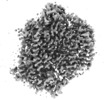




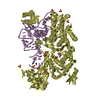
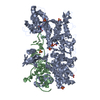
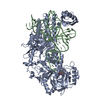
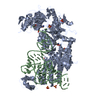
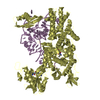



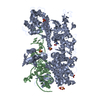
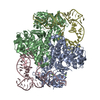
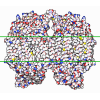

 Z
Z Y
Y X
X

























